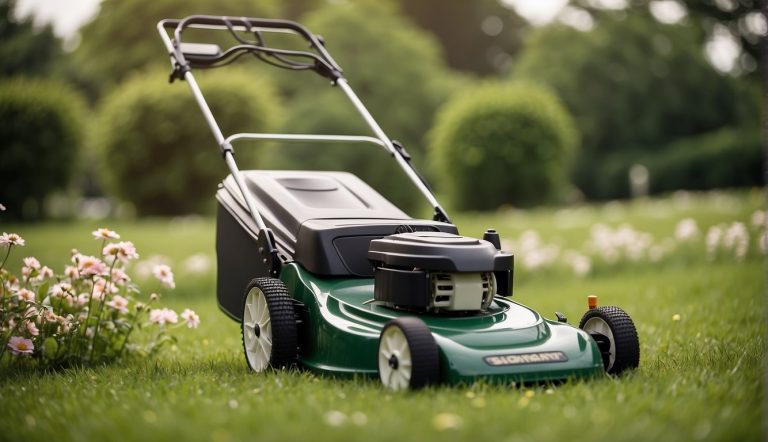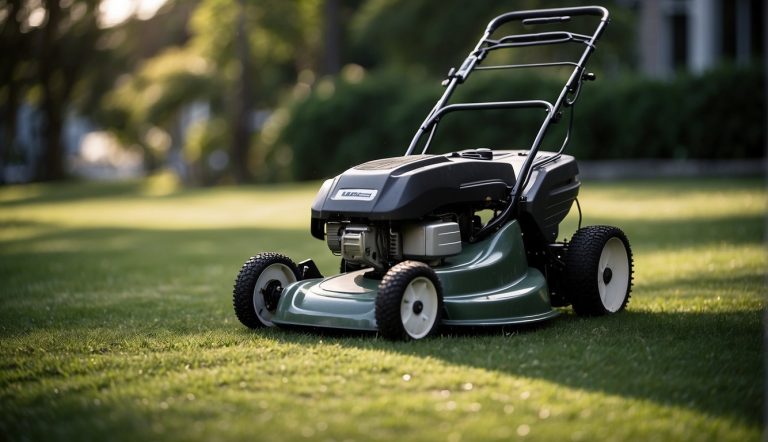How to Choose a Lawn Mower: Your Easy Guide to the Perfect Cut
Choosing the right lawn mower for your garden can be a bit like selecting a car; what suits one person’s yard might not be the best choice for another.
When faced with the myriad of options on the market, from push mowers to robotic assistants, it can feel overwhelming to pinpoint the one that will fit your needs best.
Yet, by considering your lawn size, the type of mower, power source, and desired features, you can narrow down the options and make a well-informed decision that ensures your lawn is both beautiful and manageable.

The size of your lawn is the first major consideration. Small to medium yards typically require a walk-behind mower, which includes reel, electric, and gas-powered models.
Large lawns tend to benefit from riding mowers, which greatly reduce the time and physical effort needed to keep expansive grassy areas trimmed.
With lawn care evolving, some homeowners opt for robotic mowers that offer convenience and efficiency, albeit with a higher initial investment.
Power source is another important factor; electric mowers are quieter and environmentally friendly but may not have the same power as gas mowers, which often provide better performance but need more maintenance.
Lastly, features like mulching capabilities, adjustable height settings, and handle comfort can further influence your choice, ensuring you have a mower that’s easy to use and suited for the job.
Key Points…
- Evaluating lawn size, mower types, and power sources is crucial for selecting the right mower.
- Comfort, maintenance, and mowing features should align with personal preferences and practical needs.
- I consider ease of use and storage options important for an optimal mowing experience.
Table of Contents
Understanding Lawn Mower Types
When I’m deciding on a lawn mower, I consider the size of my lawn and my personal convenience. There are three main types that cater to different needs: walk-behind, riding, and robotic mowers.
Walk-Behind Mowers
Walk-behind mowers are the most common and come in two varieties: push mowers and self-propelled mowers.
For small to medium lawns, a push mower is affordable and straightforward. I often recommend self-propelled models if the lawn is larger or on hilly terrain since they assist in moving the mower forward with less effort.
- Push Mower: Ideal for flat, small yards. Requires physical effort to move.
- Self-Propelled Mower: Best for larger or sloped lawns. Moves itself with minimal effort from me.
Riding Mowers
Riding mowers are perfect when I’m dealing with a large expanse of grass. They save time and energy, especially if my property is more than half an acre. These come in various sizes and horsepower, so I make sure to pick one that suits the size of my lawn.
- Standard Riding Mower: Suitable for large, flat lawns.
- Zero-Turn Riding Mower: Offers high maneuverability, better for lawns with obstacles.
Robotic Lawn Mowers
Robotic lawn mowers are a convenient, hands-off option that I like for maintaining my lawn regularly without any effort on my part. They’re electric, battery-operated, and can be programmed to mow on a schedule.
- GPS Feature: Some models allow me to define the mowing area using GPS.
- Programmable Schedule: I can set them to mow at specific times and days.
Choosing the Right Mower for Your Lawn Size
When I’m selecting a mower, I consider my yard’s size first because different sizes require different types of mowers for efficiency and convenience.
Small Yards
For small yards, typically less than half an acre, I recommend walk-behind mowers. They are cost-effective and easy to store. A push mower is perfect for yards up to 1/3 acre, ensuring I can maintain the yard with minimal effort:
- Manual Reel Mowers: Ideal for very small, flat yards.
- Electric/Battery Mowers: Great for reducing noise, and I don’t have to deal with gas.
- Gas-Powered Push Mowers: They offer a bit more power, which can be useful for slightly larger or uneven areas.
Medium to Large Yards
For yards that are half an acre to two acres, riding mowers and lawn tractors become my friends due to their speed and less manual effort:
- Riding Mowers: Best for yards up to 1 acre. They make mowing a breeze and reduce physical strain.
- Lawn Tractors: With more power and larger cutting widths, they’re a go-to for yards up to 2 acres.
For yards larger than 2 acres, zero-turn mowers come into play as they offer efficiency and maneuverability that’s unmatched, especially if there are many obstacles like trees or garden beds. They’re capable of quick turns and fast cutting which saves me time.
Power Source and Performance
When I choose a lawn mower, I always consider the balance between the power source and the mower’s performance. This decision impacts the mower’s efficiency, run time, and overall convenience.
Electric and Battery-Powered Mowers
Electric and battery-powered mowers are great for their lower emissions and quiet operation. I find that cordless electric mowers offer substantial cutting efficiency, some close to 89.55%, and they transform battery power into mechanical energy very effectively.
A key consideration for me is the battery run times, which can vary significantly between models. A high-efficiency battery can power a mower long enough to cover my lawn on a single charge.
Gas-Powered Mowers
Gas mowers, on the other hand, are known for their powerful gas engines which generally exceed electric mower performance, especially on tough terrain. However, I always remind myself that with this power comes the responsibility of managing fuel and engine maintenance.
The performance of gas-powered mowers is usually consistent throughout their run time and not limited by battery capacity. I find their autonomy beneficial for larger lawns where an electric mower’s battery might not last.
Mowing Features and Capabilities
When I choose a lawn mower, I always pay close attention to how well it can manage grass clippings and adapt to different terrains—these are crucial to maintaining a pristine lawn.
Cutting Height and Clippings Management
To achieve the perfect cut, cutting height is fundamental. Lawn mower models can vary significantly in their cutting height options. Typically, I find mowers with height settings that can be adjusted from as low as 1 inch up to over 4 inches.
Managing lawn clippings efficiently has led me to choose between mulching, bagging, or side-discharging features:
- Mulching: Mowers with mulching capabilities cut clippings into fine pieces that decompose quickly, returning valuable nutrients to my lawn.
- Bagging: For a tidy yard free of clippings, bagging is my go-to. This feature collects grass clippings into a bag attached to the mower for easy disposal.
- Side Discharge: When I prefer not to mulch or bag, side discharge ejects clippings out of the side of the mower, which is particularly useful for thick or tall grass.
Drive Types and Terrain Handling
The drive type of a lawn mower determines how it moves across the lawn. For different terrains, a specific drive type may be more suitable:
- Rear-Wheel Drive (RWD): Provides better traction at the center of the mower, which I find helpful for hilly terrain.
- Front-Wheel Drive (FWD): Offers easier maneuverability. I usually prefer this for flat terrains as it allows me to turn the mower on a dime by simply lifting the front wheels off the ground.
- All-Wheel Drive (AWD): For the most challenging, uneven terrains and inclines, AWD mowers provide power to all four wheels, improving stability and effort I need to exert.
When considering the mowing capabilities, I also look for features like the steering wheel and turning radius. A tighter turning radius makes for better handling around obstacles, making my mowing experience much more efficient.
Comfort, Maintenance, and Storage
Choosing the right lawnmower is important for not only the health of your lawn but also for your comfort and convenience. Let’s discuss how comfort features and efficient maintenance and storage can enhance your lawn mowing experience.
Ease of Use and Comfort Features
For a comfortable mowing experience, I always consider the ergonomics of the handle, the presence of vibration dampening, and ease of maneuverability. Here’s what I look for:
- Ergonomic Handles: A comfortable grip reduces hand fatigue.
- Seat Comfort (for ride-on mowers): Ample cushioning and back support matter for long mowing sessions.
- Low Vibration: This minimizes discomfort and long-term strain on my hands and arms.
- Variable Speed Control: It allows me to set a comfortable mowing pace.
Comfort features and predicted reliability contribute to the overall score of a lawn mower. I pay close attention to owner satisfaction ratings as they often reflect the comfort and usability of the mower.
Maintenance and Storage Solutions
I aim for a balance between performance and the ease of maintenance and storage. Here’s a breakdown of what’s important to me:
- Maintenance: Easy access to oil check and replacement parts keeps my mower running smoothly.
- Storage: A compact design or folding handles provide a space-saving solution in my garage or shed.
A table helps me remember the maintenance schedule:
| Maintenance Task | Frequency |
|---|---|
| Oil Check | Before each use |
| Blade Sharpening | Twice per season |
| Air Filter Check | Every 25 hours of use |
For storage, I love lawnmowers with a vertical storage option, reducing the footprint considerably. And, as an added bonus, features such as a hose washout port simplify cleaning, which is essential before I put my mower away.
Focusing on convenience features like one-touch height adjustment lever and easy-to-empty grass bags can save time and boost my overall mowing experience.
Frequently Asked Questions
In this section, I’ll cover some of the most common queries you might have when choosing the right lawn mower for your needs, from yard size to mower features and brands for durability.
What factors should I consider when selecting a lawn mower for my yard size?
For smaller yards, a manual push mower might be sufficient. But if you have a larger area, you’ll want to look at self-propelled or riding mowers to save time and effort.
Which features differentiate self-propelled mowers from push mowers?
Self-propelled mowers have a transmission that drives the mower forward, requiring less effort from me to push it.
On the other hand, push mowers rely on my own force to move and cut the grass.
What are the advantages of electric lawn mowers over gas-powered ones?
Electric lawn mowers are quieter, require less maintenance, and are environmentally friendly since they don’t emit exhaust.
They’re also easier to start compared to gas-powered mowers.
How do I determine the best lawn mower engine size for my gardening needs?
The engine size for my lawn mower should correlate with the size of my lawn. Large lawns often require mowers with bigger, more powerful engines, while smaller or flatter lawns can do well with smaller engines.
What should I look for in a manual lawn mower when handling smaller lawns?
For a manual lawn mower, I ensure it has sharp blades for a clean cut and adjustable height settings. It should also be lightweight and maneuverable to make the task easier.
In terms of longevity and maintenance, which lawn mower brands stand out?
Brands like Honda, John Deere, and Husqvarna are reputed for their durability and long-term performance.
They often offer robust build quality, excellent customer service, and parts availability.







